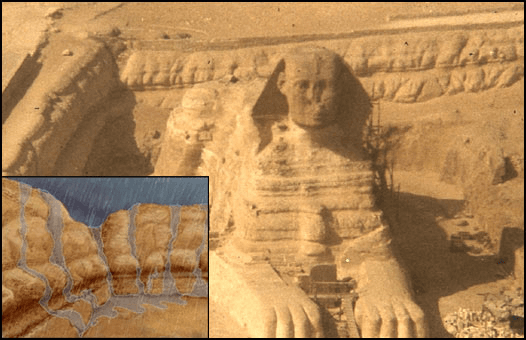
The Sphinx Erosion Mystery: Did an Ancient Civilization Precede the Pharaohs?
What Is the Great Sphinx?
- The Great Sphinx is the world’s largest and oldest monolithic statue
- Carved from a single block of limestone, it stands 73 meters long, 20 meters high, and faces directly east
- Officially, it was built during the reign of Pharaoh Khafre (~2500 BCE), the same ruler credited with the second pyramid at Giza
But something doesn’t add up…
The Erosion That Shouldn’t Be There
In the 1990s, geologist Dr. Robert Schoch examined the Sphinx and noticed something strange:
- The body of the Sphinx shows deep, rounded, vertical erosion
- The limestone enclosure walls surrounding the Sphinx also appear heavily weathered
This type of erosion? It’s caused by sustained rainfall — not by wind or sand, the usual forces in the Egyptian desert.
But here’s the catch:
The Giza Plateau hasn’t seen significant rainfall in over 5,000 years.
This suggests the erosion occurred during a much wetter time — potentially as far back as 7000–9000 BCE.
Implications That Shake History
If Schoch and others are correct, then the Sphinx:
- Was not built by Pharaoh Khafre, or anyone during dynastic Egypt
- Predates the Old Kingdom by 4,000+ years
- May have been built by a completely unknown civilization, now lost to time
That would rewrite the entire timeline of human civilization.
Alternative Theories and Controversy
🗿 1. The Lost Civilization Theory
Proponents like Graham Hancock argue that the Sphinx may be a relic of a forgotten advanced culture that existed before the end of the last Ice Age — perhaps even Atlantis.
They point to aligned astronomical features, such as the Sphinx facing Leo, as intentional markers of a much older origin.
🛕 2. Recarved Head Hypothesis
The Sphinx's head is disproportionately small. Some believe it was originally a lion, and only later recarved into a pharaoh's face, possibly by Khafre himself.
That would explain the mix of styles and unusual wear patterns.
🔬 3. Orthodox View (Mainstream Egyptology)
Traditional scholars reject these theories, attributing the erosion to wind and sand, and asserting that all nearby monuments align with Khafre’s reign.
No records exist from earlier civilizations, they argue — and no tools or structures predate Egypt’s dynastic rise.
But critics respond: absence of evidence isn’t evidence of absence.
Why This Still Matters
If the Sphinx is older than we think, it would mean:
- Civilization began earlier than we believe
- A forgotten chapter of human history lies beneath Egypt
- Our current understanding of early technology and architecture is missing something major
And so far, no one has explained away the erosion.
The Sphinx Remains Silent
“Its nose may be broken, its face defaced — but its mystery endures.”
Whether the Sphinx was built by Egyptians, a forgotten people, or some even older civilization, one thing is certain:
It’s older than it should be, and it may have seen things we can’t remember.